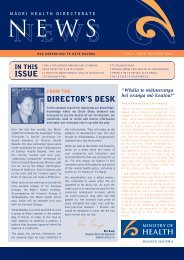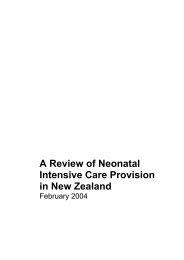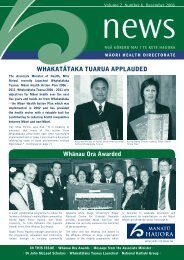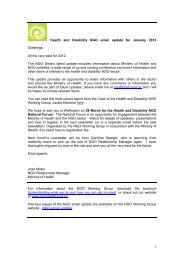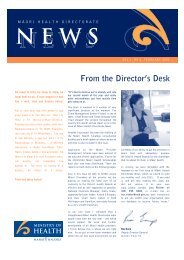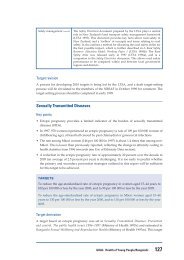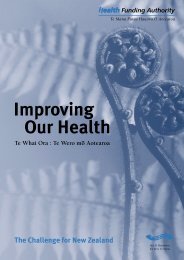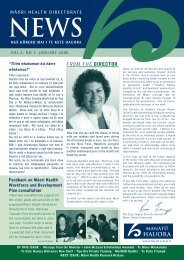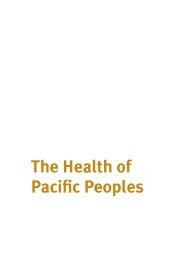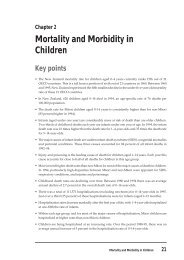breastscreen aotearoa an independent review - Ministry of Health
breastscreen aotearoa an independent review - Ministry of Health
breastscreen aotearoa an independent review - Ministry of Health
Create successful ePaper yourself
Turn your PDF publications into a flip-book with our unique Google optimized e-Paper software.
5.3.4 Routine Rescreens. The second Lead Provider to reach the 70% target, BSHC,is one <strong>of</strong> those which took part in the pilot study when 75% coverage resulted from acombined approach using both general practitioners <strong>an</strong>d the Electoral Roll (discussedfurther below) to recruit women. This Lead Provider's catchment population did notincrease between the pilot phase <strong>an</strong>d the start <strong>of</strong> BSA, with the result that its screeningactivity now comprises mainly routine rescreens, except for the youngest age-group.Invitations for rescreening are sent directly to women, <strong>an</strong>d coverage is steady ataround 72%.5.4 Development <strong>of</strong> a national age-sex register for health purposes. The success<strong>of</strong> BSS, in reaching nearly 80% coverage, confirms a wealth <strong>of</strong> evidence thatindividual invitation, combined with a provisional appointment, <strong>an</strong>d a letter <strong>of</strong> supportfrom a known health worker, is more successful th<strong>an</strong> even the very best package <strong>of</strong>health promotion, (which aims to educate not to recruit). But invitation implies that<strong>an</strong> accurate register, containing each wom<strong>an</strong>’s name, date <strong>of</strong> birth, <strong>an</strong>d current addressmust be available. Clearly GPs’ age-sex registers are a good model but, within thepresent primary care system in New Zeal<strong>an</strong>d, are not ideal for the BSA programme asa whole for a number <strong>of</strong> reasons. They are not universally available. Taken as a wholethey may contain duplicates because a wom<strong>an</strong> may consult as m<strong>an</strong>y differentpractices as she chooses <strong>an</strong>d thus appear on more th<strong>an</strong> one register. When a wom<strong>an</strong>leaves a practice, for example when she moves to a different part <strong>of</strong> the country, herrecord does not go with her. And. m<strong>an</strong>y different computer systems may be used byGPs <strong>an</strong>d IPAs to store their registers.One single national computerised age-sex register would provide the <strong>an</strong>swer. It wouldbe <strong>of</strong> benefit to the whole population for m<strong>an</strong>y different public health services,ensuring equal access for all. It would also enable eligible groups to be invited toparticipate in programmes such as immunisation or screening, which is particularlyimport<strong>an</strong>t among those who might not otherwise be aware <strong>of</strong> their entitlement. Asfar as BSA <strong>an</strong>d cervical screening are concerned it would have m<strong>an</strong>y adv<strong>an</strong>tages.Firstly it would provide a me<strong>an</strong>s <strong>of</strong> individually inviting every eligible wom<strong>an</strong> whenher screen was due. Secondly the date <strong>of</strong> each invitation <strong>an</strong>d, for those who accepted,date <strong>of</strong> screening <strong>an</strong>d summarised information <strong>of</strong> the outcome in terms <strong>of</strong> routinerecall, referral for assessment, diagnosis <strong>of</strong> breast c<strong>an</strong>cer, or other reason for exitingthe programme, could be added, thus building a national database <strong>of</strong> every eligiblewom<strong>an</strong>’s screening history. For women who moved to a new area this would give hernew Lead Provider the date on which she was next due to be invited, as well asproviding information on the true population coverage <strong>of</strong> BSA. Thirdly, someknowledge <strong>of</strong> reasons why women did not wish to participate (e.g. because they werehaving private mammography, or because they were already being followed up after<strong>an</strong> earlier diagnosis <strong>of</strong> breast c<strong>an</strong>cer) could be investigated. Fourthly, it would assistthe Lead Providers in scheduling their screening sessions, which would be <strong>of</strong>particular value for their mobile units which at present <strong>of</strong>ten have to guess at thenumber <strong>of</strong> “new” women who may attend either by dropping in or by calling theFreephone number.5.5 There are a number <strong>of</strong> different possibilities for compiling such a nationalpopulation register.13



